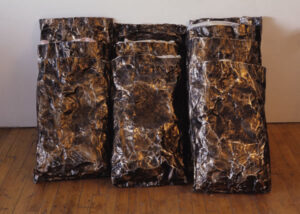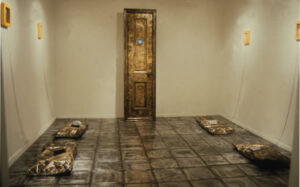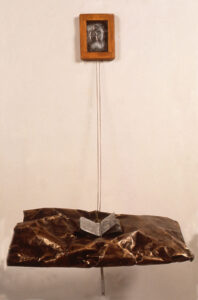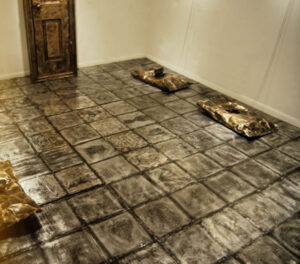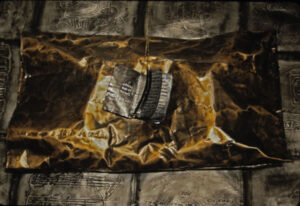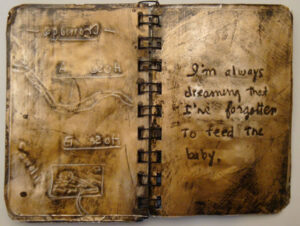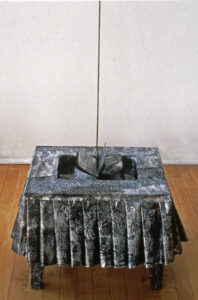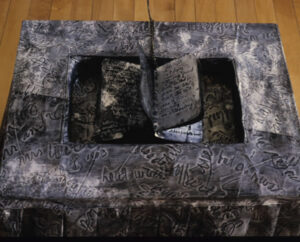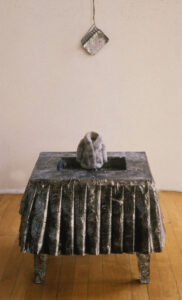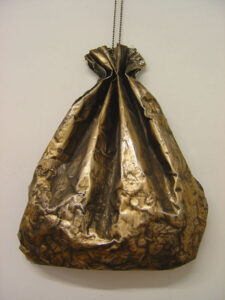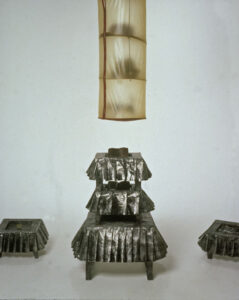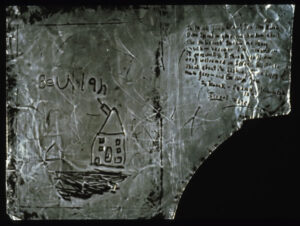PICTURE/PILLOW/STORY:
pillows, bags, door, floors and bed time stories
In the mid nineties while still working in shelters and hospitals as well as in my studio, I came across hundreds of feather pillows for sale at a local convent that was closing. This began a series of etched metal pillowcases (embedded with video monitors), bags, ruffled tables, beds and other trappings of the domestic environment relocated to extraordinary circumstances and institutions. I still hope to make an entire room filled with soft down pillows in rigid metal pillowcases before I go to sleep permanently. In addition to their metaphorical content in relation to the community-based work I was doing, I began to think much of my work and life are just about finding a place to rest. I am always taking naps in my studio. Many of my most important ideas and images come from that state between waking and sleeping. In between there are always drips dripping, bodies tossing and thoughts of other beds in better times and other places.
Gilmor’s installation titled ‘Bed Time Stories,’ or alternately, ‘Picture/Pillow/Story consists of a narrow door from Gilmor’s now demolished home, covered with sheets of metal and inset with a small television screen. Playing on the television is a loop of video images take from some old home movies Gilmor purchased at a yard sale.
The floor in front of the door is covered with squares of the same sheet metals as the door, etched with pictures and stories by children who were or are patients at the University of Iowa Hospitals at Iowa City. The etched squares display a wide range of emotions and ideas. They are at the very least disquieting. Some are downright disturbing, but most are quite poignant.
For example, one square has these words, written in a child’s hand: “My name is Holly. I had brain surgery. I was very scared. I have been brave. I want to go home. I am a farm girl. I love animals. At the bottom of the square is her etched drawing of a rabbit.
On the gallery walls encircling the etched floor are five framed etched pieces of metal. These images were found in the trash at a school in London where Gilmor was a visiting artist last summer. They are physically tied with chains to small notebooks titled Home Management I, A Letter to the Editor, Letter From Phoenix and Letter From Dublin. These notebooks are resting on pillows that have been covered with etched metal pillowcases.
The overall effect is that of a sort of hospital ward or shelter.
The irony of those two possibilities, notes Gilmor, is that patients are in bed all of the time, and homeless people are always looking for a bed-and both tend to be unhappy about their situation. Further, there are connotations that attach themselves to beds that aren’t always comfortable, that beds in a domestic situation are loaded with meanings. These loaded meanings reflect on the theme of the work, which is dysfunction.
Elliot Nusbaum, Three Artists Offer Art Dreamscapes, The Des Moines Register Arts Section, page 1, October 29, 1995

